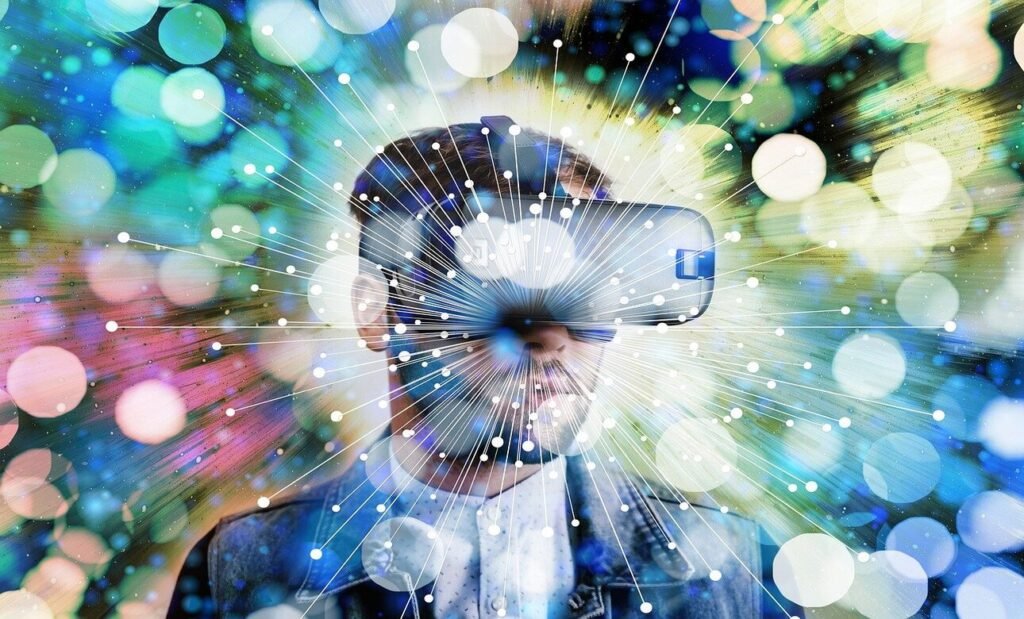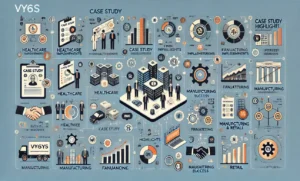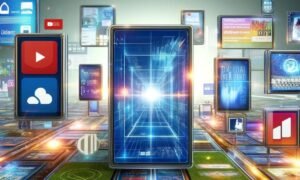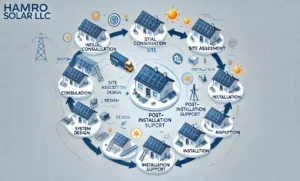The Impact of Augmented Reality on Various Sectors

Augmented reality (AR) is transforming several sectors by overlaying digital content on physical objects and consequently generating a new level of interaction with the immediate environment. In contrast to virtual reality (VR), which engulfs users in a fully simulated electronic world, AR enhances real-life experiences by merging them with virtual elements. This field is gradually growing and has significant implications across industries like healthcare and retail.
What is Augmented Reality (AR)?
Augmented reality (AR) involves mixing 3D elements such as graphics, video, or even three-dimensional models with what we see in the actual world. Unlike Virtual Reality (VR), which builds an entirely artificial digital space for people to exist in, AR technology improves our physical environment by combining digital information and items into the actual world we perceive.
Users can manipulate these virtual additions via diverse tools like smartphones, tablets, or specialized goggles designed for augmented reality. It is this difference that blurs the line between virtual and real aspects, creating both informational and interactive blended experiences for AR users.
What are the Differences Between AR and VR?
Though immersive experiences are offered by both AR and VR, they vary greatly in their applications as well as user experience. By overlaying digital information on existing surroundings of the user, Augmented Reality enhances the real world, improving users’ interaction with their physical environment. In contrast, virtual reality produces an entirely artificial environment that engulfs its user, replacing everything he or she sees in his/her place.
The ability of AR to integrate with nature is a unique characteristic that is useful in several sectors where it can enable context-based content provision and interactive experiences.
Augmented Reality Applications Across Different Industries
Augmented Reality is no longer just talk about the future—it has changed the way businesses work while influencing how consumers interact with products and services. Here, we will go over some major fields that have been impacted by AR.
Healthcare
Surgical Assistance and Training
Augmented Reality has sparked disruption in the medical field, particularly in the area of surgery. It has empowered surgeons to use AR to see three-dimensional patient anatomies superimposed over them while operating for better accuracy in surgeries. Not only is this transformative technology just a tool, but it also becomes a light of hope for future healthcare.
For example, AR can provide real-time data and visual aids to help plan and execute intricate procedures when needed. In addition, it plays an important role in medical training systems because students may simulate procedures with immediate responses that boost learning outcomes as well as readiness.
Patient Care and Rehabilitation
Augmented Reality (AR) applications are revolutionizing patient care and rehabilitation as well. By making recovery more stimulating and efficient through interactive rehabilitation exercises personalized to individual needs, AR is making a difference. These exercises have instant response, thus enabling patients and therapists to monitor progress closely during the entire period of rehabilitation process, which even makes sense for them all.
Retail
Virtual Try-Ons
One of the most obvious and interesting uses of AR in retail involves virtual try-ons. This is the new technology that allows a person to virtually see how clothes, accessories or makeup would appear on them without having to physically wear them.
Sephora and Warby Parker are some of the companies that have employed AR mirrors and apps to improve their customers’ shopping experience as well as reduce returns hence enhance customer satisfaction and boost sales levels. These conveniences plus efficiencies are just part of what the future will look like for AR in retail.
Enhanced Shopping Experience
AR also transforms in-store experiences by providing additional information about products. Customers can use AR apps to scan product labels or packaging and receive detailed information, reviews and recommendations for complementary products. This interactive shopping experience not only informs consumers but also increases their engagement with the brand.
Real Estate
Virtual Property Tours
In relation to the comfort of their homes, AR allows potential buyers to tour houses virtually. Using AR, it is possible for users to find out the layout and design of a house as well as see how their furniture pieces would fit in.
The technology simplifies the process of purchasing homes by allowing people to make well-informed choices about what they want, thus reaching a large audience, including those who are far away.
Design and Visualization
AR is a priceless tool that assists interior decorators and architects with their work. It makes it possible for them to overlay digital furniture and decorations on real-life spaces, thereby enabling clients to visualize the modifications before undertaking them. This has become very useful when planning for any form of renovation or constructions since it has increased accuracy levels leading to client satisfaction.
Education
Interactive Learning
To provide more interaction and keep learners busy, AR is transforming education into an exciting experience. 3D-based technology can be used by students to learn historical events, scientific theories, and complex structures mentioned on textbooks’ pages. For example, biology students can dissect a virtual frog. In contrast, history students can feel themselves living among ancient civilizations through immersive experiences created by AR technology.
In addition, this approach improves understanding and memory retention while fostering interest and engagement in learning which consequently enable the effectiveness of education.
Enhancing Textbooks
AR is being used in traditional textbooks. By adding things like 3D models, videos, and quizzes, AR changes static content into dynamic learning tools. Learning becomes more enjoyable as well as it helps students to comprehend and retain complex information; thus it is revolutionary for the ways in which students learn.
Tourism and Hospitality
Augmented Tours
AR has made tourism more exciting because it offers tours that are interactive and informative. Tourists can use AR apps to receive detailed information about landmarks, historical sites, and museums while on the go, enriching their experience. For example, AR can give historical background, interesting facts or let one interact with maps thereby making an ordinary trip an educational adventure.
Navigation and Information
Hotels and resorts benefit from an AR feature that provides guests with interactive maps showing amenities. These include virtual concierge services, wayfinding assistance, and referrals to nearby attractions that significantly improve guest experience, enabling businesses stand out in a competitive market.
Automotive
Heads-Up Displays (HUDs)
The integration of AR into automotive systems through Heads-Up Displays (HUDs) is on the rise. These systems display vital driving information like speed, directions or warnings onto the windshield, where drivers can access important data while keeping their eyes on the road. This union makes modern vehicles safer and more effective.
Enhanced Navigation
AR enhances navigation by superimposing direction signs and points of interest directly onto a real-world view as seen through a windshield of a car or smartphone app. As such, it improves navigation that has been made more intuitive than before; thus, reducing chances of making mistakes during driving.
Manufacturing and Industry
Maintenance and Repair
Augmented Reality is changing maintenance and repair tasks in industrial settings. Technicians are assisted to perform better with AR, which overlays stepwise instructions accompanied by diagrams over machines. It reduces downtime, increases productivity hence minimizing chances of errors hence making AR an indispensable manufacturing tool.
Training and Simulation
Similarly, AR is used in manufacturing set-ups to train employees. This enables workers to participate in simulated situations that will give them first-hand experience without the fear of any real-world impacts. This helps them hon their skills and prepares them for complicated tasks, hence improving overall operational efficiency.
Augmented Reality (AR) Examples in Everyday Life
Everyday life is immersed in AR, which enriches practical activities as well as amusement. Here are some examples:
1. Pokémon GO
Pokémon GO is a game app that uses augmented reality to mix computer graphics with images from real world videos or camera frames on mobile devices. Players can see Pokémon through their phones’ cameras superimposed onto what they see around them, and they catch them by throwing Poké Balls at them, among many other gaming features. The popularity of this game manifested AR’s potential for making games more immersive.
2. Google Lens
For instance, by simply pointing their mobile device cameras at objects or points of interest, such as landmarks, plants, and animals, users can access information on such an item using the built-in Google lens functionality from within the Google Assistant application on Android smartphones and tablets.
Additionally, it has the capability of recognizing texts written in foreign languages acting like a small dictionary by translating automatically those words into English language, scanning food items’ barcodes so that you will know nutritional details about them only by looking at each package through your phone’s camera; all these functions make it an everyday versatile tool for consumers who need quick information on different items they interact with throughout the day.”
3. Snapchat Filters
Snapchat has several augmented reality filters that change the way users look or add digital things to their own selfies and videos. It can be used to apply virtual makeups, change backdrops or create interactive effects while sharing photos and videos.
4. IKEA Place
IKEA Place is an app that enables you to use your phone’s camera to see what a piece of furniture would look like in your house. For example, it uses the camera on a smartphone to overlay virtual furniture over their living rooms, which helps them make more informed decisions about purchasing and plan room layouts better.
5. Microsoft HoloLens
Microsoft HoloLens is an AR headset that blends real-world with virtual content by projecting digital content into the user’s environment. It has a variety of uses, such as industrial design, medical training, and teamwork, among other applications, whereby users can engage with holography objects and data using great immersion level.
Conclusion
With improved interactions, increased efficiencies, and immersive experiences, Augmented Reality is reshaping a multitude of sectors. There will be even more opportunities for AR technology in various industries, as it develops further into the future thereby driving innovation. In the coming years, AR will transform healthcare, retail, automotive and more as we know it thus redefining our relationship with the world.
FAQs about Augmented Reality (AR)
What is Augmented Reality (AR) and how does it function?
Augmented reality (AR) generally refers to a technological overlaying of digital content, such as pictures or videos in a physical environment in real-time. The application of AR entails using an electronic gadget like a cell phone or tablet, through its camera lens, which commences capturing the surrounding environment. Afterward, this information goes through processing by these devices which are then used to display their integration with other digital components on top of them being superimposed upon the real world. This provides a kind of mixed reality where both actual and virtual objects can be faced at once by users.
What makes Augmented Reality (AR) different from Virtual Reality (VR)?
The two technologies are immersive experiences, but the way they work and where they can be used is what distinguishes them. Augmented Reality (AR) enhances the real world by overlaying digital information on a user’s physical view, enabling interaction with both real and virtual elements. Contrarily, Virtual Reality (VR) creates fully immersive digital environment that replaces the users’ entire physical surroundings, thus taking them to a totally virtual world.
What industries are being transformed by Augmented Reality (AR)?
Augmented Reality (AR) is transforming numerous industries, including;
Healthcare: Improving surgical precision and training programs.
Retail: Giving opportunities for virtual fittings and interactive shopping.
Real Estate: Enables virtual property tours and design visualization.
Education: Creating interactive learning experiences as well as enhanced textbooks.
Tourism/Hospitality: Provision of augmented tours and interactive guest services.
Automotive: Integration of heads-up displays with improved navigation systems.
Manufacturing: Support for maintenance, repair, and training through AR simulations.
In what way does Augmented Reality (AR) enhance the retail shopping experience?
In brief, AR makes retail customer transactions easy by making customers enable to virtually try on products such as clothes, accessories, or make-up without any physical interaction with them. This can be done through AR mirrors or mobile apps, thereby making shopping more convenient and personalized. Moreover, AR adds value to brick-and-mortar businesses, for instance, product reviews, detailed descriptions of products, and complementary items, among others, which can be accessed through AR devices.
Can Augmented Reality (AR) be used for educational purposes?
It is true that augmented reality (also known as AR) is now being put into good use in learning institutions in order to create a more interactive and engaging learning environment. Through AR technology, textbooks are able to become alive with quizzes, videos, and 3D models that students can interact with. This enables learners to study complex concepts like scientific processes or historical events in a very different immersive manner, leading to dynamic and efficient learning.
Can you provide some examples of Augmented Reality (AR) being used in everyday life?
Examples of Augmented Reality (AR) in everyday life include:
Pokémon GO is mobile game that overlays virtual creatures onto the real world environment.
Google Lens is an application that can tell the user about items, plants, or even landmarks by simply looking at them.
Snapchat Filters are AR filters for selfies and videos that you can use to add digital elements.
IKEA Place is an AR app that allows you to see what furniture would look like in your home.
What does the future hold for Augmented Reality (AR) technology?
With many more improvements to come in various sectors, the future of augmented reality (AR) looks bright. By becoming more sophisticated, AR will become a normal part of our everyday lives. It might include more immersive AR experiences in healthcare and education and the rise of mainstream AR devices like glasses. This could also mean that the ways people interact with both digital and physical worlds will drastically change as AR continues developing.






